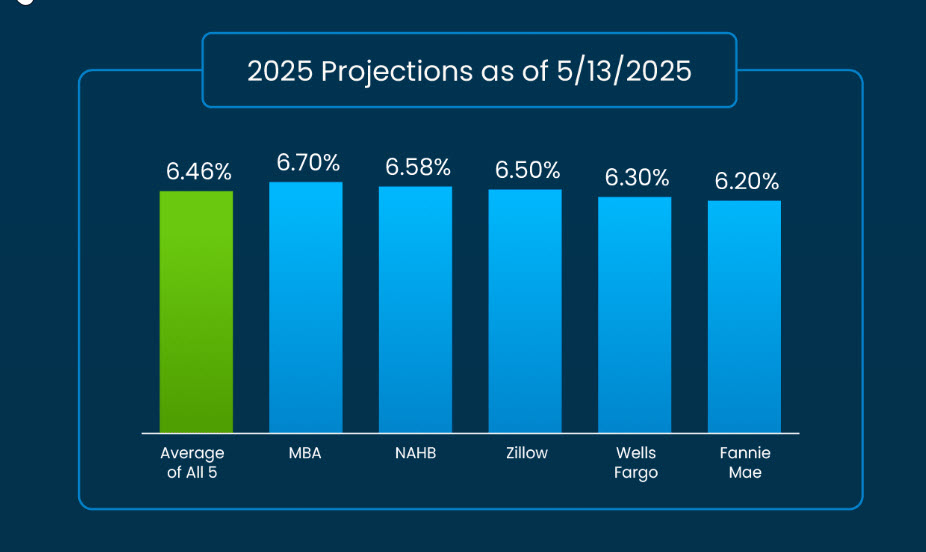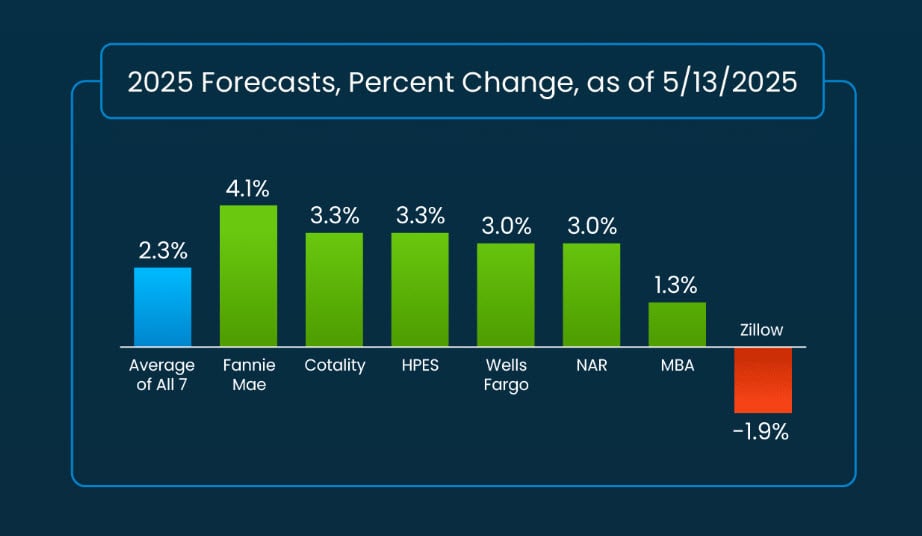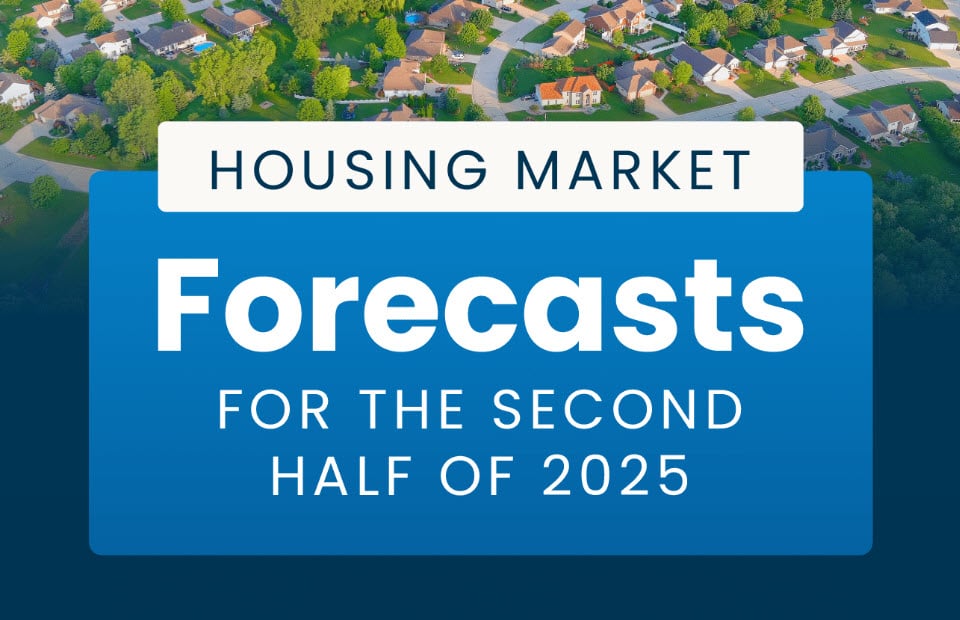The 2025 housing market is shaping up to be a game-changer, with mortgage rates, inventory levels, and home prices all set for significant shifts. As a real estate pro or investor, you need to stay ahead of these changes to make smart moves. This article digs into the nitty-gritty of what's coming down the pike, giving you a clear picture of where the market's headed. We're talking hard numbers on mortgage trends, a deep dive into housing stock predictions, and a no-nonsense look at price forecasts. But we're not just throwing data at you - we're breaking down what it all means for your bottom line. You'll get practical tips on how to use this info to your advantage, whether you're looking to buy, sell, or invest. We've got tools to help you crunch the numbers and personalized advice to keep you from stumbling. The economy's always throwing curveballs, and we'll show you how to knock them out of the park. Ready to get the inside scoop on making the most of the 2025 housing market? Let's dive in and set you up for success.
Interest Rates and Affordability

The financial landscape has shifted dramatically since 2022, when mortgage rates doubled from 3.5% to nearly 7%. This sharp increase reshaped buying power and market dynamics, creating a ripple effect that continues to influence property transactions in 2025.
Current Market Statistics
Mortgage rates remain above 6.5% despite three consecutive rate cuts at the end of 2024. This persistence stems from ongoing inflation concerns and broader economic factors. Treasury yields play a crucial role in determining these rates, as lenders benchmark their mortgage-backed securities against these government instruments to maintain competitive positioning.
Future Rate Projections
Morgan Stanley's analysis points toward a gradual decline in mortgage rates through 2026. This forecast considers multiple economic indicators and market pressures. The Treasury Department's commitment to reducing yields signals potential relief for prospective homeowners. These changes could spark renewed activity in previously stagnant market segments.
Cost Management Strategies
Buyers can leverage several approaches to navigate the current rate environment. Points buying presents one option, allowing upfront payment to secure lower long-term rates. Rate monitoring tools help track daily fluctuations, enabling quick action when favorable conditions emerge. Building a larger down payment reduces the loan amount, potentially qualifying for better rates through decreased lending risk.
Developing relationships with multiple lenders creates competition for your business, often resulting in more favorable terms. Understanding debt-to-income ratios and maintaining strong credit scores positions buyers to secure optimal financing terms. Short-term adjustable-rate mortgages might offer lower initial rates for buyers planning to refinance or sell within a specific timeframe.
Setting up automatic payment systems ensures timely mortgage payments, protecting credit scores and avoiding unnecessary fees. Regular market monitoring helps identify refinancing opportunities when rates decrease. Strategic timing of purchase offers during slower seasons might provide additional negotiating leverage on both purchase price and financing terms.
Housing Inventory Changes

Property availability has shifted dramatically since late 2024, with a 15% uptick in residential listings across major metropolitan areas. The supply chain bottlenecks that previously restricted new construction have eased, allowing developers to complete delayed projects and introduce fresh stock to the market.
Multiple data points indicate a market moving towards what experts call "a more balanced state", creating opportunities for strategic positioning.
Residential construction permits have doubled in suburban zones, particularly in areas with strong job markets and growing tech sectors. This surge addresses the previous shortage that drove bidding wars and inflated prices beyond sustainable levels. Data shows national price growth predictions of 1.77% for 2025, signaling a return to historical appreciation patterns.
Regional Variations
The Northeast corridor maintains the tightest supply, with Boston and New York showing less than two months of available housing stock. Meanwhile, the Southeast and Southwest regions demonstrate robust growth in single-family home construction, particularly in secondary markets like Nashville and Austin. Mid-sized cities in the Midwest have experienced the most significant percentage increases in available properties, driven by migration patterns and remote work flexibility.
Mountain states report substantial variations between urban and rural markets. Cities like Denver and Salt Lake City maintain competitive markets while surrounding areas show increasing availability. The Pacific Northwest demonstrates similar patterns, with Seattle and Portland experiencing different inventory dynamics than their suburban counterparts.
Impact on Strategies
These supply shifts require adapted approaches for both buyers and sellers. Sellers must price properties more precisely, as the expanding options give buyers increased negotiating power. The key differentiator becomes property condition and location rather than mere availability. Marketing strategies now emphasize unique features and value propositions instead of relying on scarcity-based urgency.
Monitoring seasonal patterns helps identify prime listing windows, though traditional timing rules have evolved with market changes. Buyers gain leverage through detailed market research and patience, particularly in areas with growing inventory. Property inspection standards have heightened importance as buyers can afford to be more selective.
Preparing properties for extended market exposure becomes crucial for sellers, while buyers benefit from exploring multiple neighborhoods and property types. Local market dynamics dictate specific approaches, with some areas still requiring quick decision-making while others allow for more deliberate evaluation processes.
Home Price Predictions

Zillow's latest analysis reveals a projected 1.9% drop in home values for 2025, contradicting their earlier forecast of a 0.6% increase. Meanwhile, Fannie Mae maintains a more optimistic stance, suggesting stable growth patterns in metropolitan areas with strong employment sectors. Wells Fargo's quarterly report splits the difference, anticipating regional variations rather than a uniform national trend.
The data shows existing home sales reaching 4.2 million in 2025, marking a 3.3% increase from previous years. This uptick stems from shifting market dynamics and changing buyer behaviors. Single-family rental properties show a projected 3.1% growth rate, while multifamily units trend toward a 2.1% increase, indicating distinct investment opportunities across different property types.
Several key factors drive these regional price fluctuations:
- Population migration patterns between coastal and inland states
- Local employment growth and wage increases
- New construction rates in expanding suburbs
- Infrastructure development projects
- School district performance rankings
- Transportation accessibility improvements
- Tech sector expansion in secondary markets
- Municipal zoning changes
- Environmental considerations and natural disaster risks
- Property tax variations by county
Strategic buyers focus on properties within growing job markets, particularly those showing consistent appreciation over the past decade. Analyzing school district improvements, upcoming infrastructure projects, and local business expansion plans helps identify potential growth areas. Monthly market reports from county assessor offices provide valuable insights into neighborhood-specific trends.
Sellers maximize returns by timing listings to coincide with peak demand periods specific to their region. Professional photography, targeted marketing campaigns, and strategic pricing based on recent comparable sales strengthen negotiating positions. Highlighting unique property features and neighborhood amenities attracts qualified buyers seeking specific lifestyle benefits.
Tracking median days on market for similar properties guides realistic pricing strategies. Studying absorption rates by neighborhood reveals optimal listing windows. Understanding local buyer demographics shapes effective marketing approaches, while monitoring pending sales indicates immediate market direction.
Regional Market Variations
Miami's residential sector stands apart from other metropolitan areas, with median home prices 40% lower than comparable coastal cities. Properties in Phoenix and Las Vegas draw significant attention from out-of-state buyers, particularly those relocating from California and Washington. The South led the nation in new housing starts in 2024, creating a stark contrast with established northeastern markets.
Dallas-Fort Worth exemplifies the rapid growth pattern of Sun Belt cities, where commercial development spurs residential expansion. Local builders have capitalized on available land, constructing master-planned communities that offer competitive pricing compared to existing homes. These developments feature modern amenities and energy-efficient designs, attracting both first-time buyers and downsizing retirees.
California's coastal markets demonstrate opposite trends, with limited buildable land creating intense competition. San Francisco's peninsula restricts outward growth, pushing development toward vertical solutions and property renovations. The tech sector's continued presence maintains pressure on housing prices, despite periodic industry adjustments. San Jose experienced a 67.6% inventory growth, yet prices remain resistant to downward pressure due to persistent demand.
Charlotte and Nashville showcase the advantages of secondary markets, where reasonable land costs enable developers to maintain steady construction pipelines. These cities benefit from corporate relocations and expanding job markets, creating sustainable demand for mid-range housing. Local zoning boards have streamlined approval processes, reducing barriers to new construction while maintaining quality standards.
The Pacific Northwest presents unique challenges, as geographic constraints and environmental regulations limit developable areas. Seattle's surrounding water and mountains create natural boundaries, while Portland's urban growth boundary affects land availability. Both cities see increasing density within established neighborhoods, with accessory dwelling units becoming common solutions for housing shortages.
Austin's tech corridor expansion drives distinctive market patterns, with new construction concentrated along transportation arteries. Mixed-use developments combine residential units with retail spaces, creating self-contained communities that appeal to young professionals. Local builders focus on speed-to-market strategies, utilizing modular construction methods to meet urgent demand while maintaining quality standards.
Denver's market reflects the growing preference for mountain-adjacent living, leading to premium pricing for properties with scenic views. Builders navigate challenging topography and weather conditions, resulting in higher construction costs that influence final sale prices. The limited building season creates cyclical patterns in new inventory availability, affecting market dynamics throughout the year.
Building material costs vary significantly by region, impacting construction decisions and final pricing. Southern markets benefit from longer building seasons and established supply chains, while northeastern projects face higher expenses due to weather delays and stricter building codes. Western states contend with additional costs from earthquake-resistant construction requirements and fire-safety measures.
Expert Recommendations for Buyers
Strategic data analysis forms the foundation of successful property acquisition in 2025. Digital tools have revolutionized how buyers research and evaluate potential investments, making informed decisions more accessible than ever before.
Leveraging MLS Data and Tools
The Multiple Listing Service platform provides real-time updates on property availability, price adjustments, and market trends. Keeping Current Matters synthesizes this data into actionable insights, highlighting emerging opportunities in specific neighborhoods. Advanced filtering options help pinpoint properties matching exact specifications – from square footage to specific architectural features.
Navigating Mortgage Pre-approval
Contending with high prices and elevated mortgage rates, as noted by industry expert Jones, makes pre-approval crucial. This process reveals exact purchasing power and demonstrates serious intent to sellers. Digital pre-approval platforms streamline documentation submission, often delivering results within hours. Rate-lock options protect buyers from market fluctuations during the house-hunting process.
Choosing Less Competitive Markets
Secondary markets offer compelling alternatives to saturated urban centers. Analyzing employment growth, infrastructure development, and population trends reveals emerging hotspots. Buyers gain advantages by focusing on areas with planned commercial development or transportation improvements. Off-peak season purchases often yield better negotiating positions and reduced competition.
Working with qualified real estate professionals maximizes success potential. Here's what to look for in an agent:
- Deep knowledge of specific neighborhoods and micro-market trends
- Strong track record of successful negotiations in similar price ranges
- Access to comprehensive market analysis tools and pre-listing information
- Established relationships with local lenders, inspectors, and contractors
- Proven ability to identify emerging market opportunities
Sharga advises buyers to "focus on long-term goals" rather than short-term market fluctuations. Professional guidance helps maintain this perspective while navigating complex transactions. Regular market analysis sessions with experienced agents reveal opportunities that automated searches might miss.
Strategies for Sellers in 2025
Smart data analysis tools have transformed property valuation methods, giving sellers precise control over their asking prices. Comprehensive market reports from local real estate boards provide detailed insights into neighborhood-specific trends, enabling sellers to position their properties competitively. Analyzing recent sales within a half-mile radius reveals accurate price points based on square footage, lot size, and property features.
Solar panels and energy-efficient windows now deliver measurable returns on investment through reduced utility costs. Modern buyers scrutinize monthly operating expenses, making energy performance ratings powerful selling points. Installing smart thermostats and LED lighting systems demonstrates forward-thinking property management while adding tangible value. Heat pump technology and improved insulation materials create year-round comfort while reducing environmental impact.
According to the National Association of Realtors, homeowners have accumulated $147,000 in housing value over five years. This equity cushion provides flexibility when considering strategic upgrades that attract qualified buyers. Fresh exterior paint, updated landscaping, and modernized kitchen appliances consistently generate strong buyer interest. Professional staging services maximize space utilization while highlighting architectural features that distinguish properties from nearby listings.
Digital marketing platforms have revolutionized property promotion strategies. High-resolution photography and virtual tours enable buyers to experience spaces remotely before scheduling in-person visits. Social media advertising targets specific buyer demographics based on income levels, lifestyle preferences, and commuting patterns. Professional video walkthroughs showcase natural light patterns and living space flow that static images cannot capture.
Successful negotiations require understanding buyer motivations and market dynamics. Ralph McLaughlin, senior economist at Realtor.com notes "the market feels close to a buyer's market." This shift demands flexible terms regarding closing dates, included appliances, and repair allowances. Presenting detailed maintenance records and home warranty options builds buyer confidence while protecting seller interests.
Preparing thorough documentation streamlines the closing process and strengthens negotiating positions. Updated property surveys, recent inspection reports, and utility consumption data support asking prices while reducing buyer concerns. Maintaining open communication with qualified buyers through their agents keeps deals moving forward while preserving professional relationships.
Setting realistic timelines manages expectations throughout the transaction process. Quick responses to inspection items and repair requests demonstrate good faith while maintaining momentum. Professional contractors standing by for immediate repairs prevent delays that could derail promising deals. Coordinating with title companies and lenders ensures smooth closings that satisfy all parties.
Actionable Tools and Resources
Digital platforms have transformed property research into a data-driven process. Market analysis software now processes thousands of data points within seconds, delivering precise valuations and trend forecasts. Professional-grade applications compile detailed reports on neighborhood demographics, school performance metrics, and economic indicators.
Essential digital resources for market analysis include:
- Property valuation calculators with machine learning algorithms
- Interactive maps showing recent sales within specific radiuses
- Customizable market report generators for different property types
- Automated comparable property analysis tools
- Neighborhood trend tracking dashboards
- School district performance metrics database
- Crime rate mapping and analysis software
- Development project tracking systems
- Zoning regulation databases
- Property tax assessment archives
Mobile applications send instant notifications when properties matching specific criteria hit the market. These alerts include price changes, status updates, and new listings that fit predetermined search parameters. Greg McBride, CFA, chief financial analyst for Bankrate notes that "markets that have seen a surge in inventory" create opportunities for strategic buyers who monitor these updates closely. Advanced filtering options enable precise targeting of properties based on square footage, lot size, architectural features, and proximity to amenities.
Making data-backed decisions requires professional guidance from certified appraisers and market analysts. These experts interpret complex market signals, evaluate property conditions, and assess future growth potential. Their insights help identify properties with strong appreciation potential while avoiding overvalued assets. Local market specialists provide detailed analysis of neighborhood-specific trends, development plans, and demographic shifts that impact property values.
Final Thoughts
The 2025 housing market presents both opportunities and challenges for buyers and sellers. Market forecasts point to stabilizing mortgage rates, gradual inventory improvements, and regional price variations that create different advantages depending on your location. These insights give you practical tools to make smart real estate decisions.
Understanding these market dynamics puts you in a better position to time your buying or selling decisions. The data and trends we've covered help you spot good deals, negotiate effectively, and manage your real estate investments with confidence. Whether you're looking to buy your first home or expand your property portfolio, knowing what's ahead makes a real difference in your success.
Remember that local markets often behave differently from national trends. Work with experienced real estate agents who know your specific area. They can help you interpret broader market signals within your local context. Stay up-to-date with reliable market reports, keep track of local property listings, and build relationships with real estate professionals who can alert you to opportunities. The more informed you are, the better prepared you'll be to act when the right opportunity comes along. Take time to review these insights regularly, and use them to create your personal real estate strategy for 2025.

